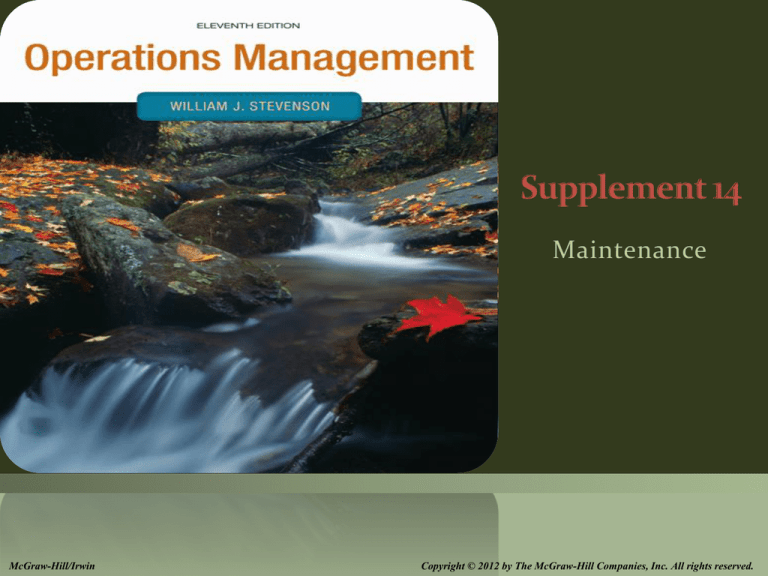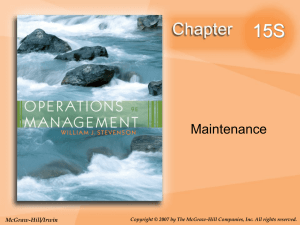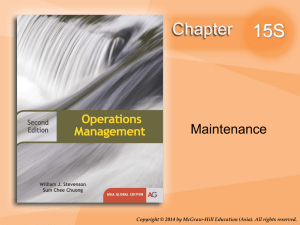
Maintenance
McGraw-Hill/Irwin
Copyright © 2012 by The McGraw-Hill Companies, Inc. All rights reserved.
You should be able to:
1.
Explain the importance of maintenance in production systems
2. Describe the range of maintenance activities
3. Discuss preventive maintenance and the key issues associated
with it
4. Explain breakdown maintenance and name the key issues
associated with it
5. State how the Pareto phenomenon pertains to maintenance
decisions
Instructor Slides
14S-2
Maintenance
All activities that maintain facilities and equipment in
good working order so that a system can perform as
intended
Maintenance activity categories:
Buildings and grounds
Equipment maintenance
Instructor Slides
14S-3
The goal of maintenance is to keep the production system
in good working order at minimal cost
Reasons for wanting to keep equipment and machines in
good operating condition:
1.
2.
3.
4.
Avoid production or service disruptions
Not add to production or service costs
Maintain high quality
Avoid missed delivery dates
Instructor Slides
14S-4
Operations capacity is reduced, and orders are delayed
2. There is no output, but overhead continues, increasing
the cost per unit
3. There are quality issues
1.
Output may be damaged
4. There are safety issues
Employees or customers may be injured
Instructor Slides
14S-5
Reactive:
Breakdown maintenance
Dealing with breakdowns or problems when they occur
Proactive:
Preventive maintenance
Reducing breakdowns through a program of lubrication,
adjustment, cleaning, inspection, and replacement of worn
parts
Instructor Slides
14S-6
Instructor Slides
14S-7
The goal of preventive maintenance is to reduce the
incidence of breakdown or failures in the plant or
equipment to avoid the associated costs
Loss of output
Idle workers
Schedule disruption
Injuries
Damage to other equipment, products, or facilities
Repairs
Inventories of spare parts
Repair tools and equipment
Repair specialists
Instructor Slides
14S-8
It is periodic
It can be scheduled according to the availability of
maintenance personnel and to avoid interference with
operating schedules
Maintenance is scheduled using some combination of
1.
2.
3.
The result of planned inspections that reveal a need for
maintenance
According to the calendar (passage of time)
After a predetermined number of operating hours
Instructor Slides
14S-9
The goal is to strike a balance between the cost of
preventive maintenance and the cost of breakdown
The amount of preventive maintenance, therefore, is a
function of the expected frequency of breakdown, the
cost of breakdown, and the cost of preventive
maintenance
Instructor Slides
14S-10
The frequency of breakdown of a machine per month is $1,000 and the
cost of preventive maintenance is $1,250 per month. If preventive
maintenance is performed, the probability of a machine breakdown is
negligible. Should the manager use preventive maintenance, or would
it be cheaper to repair the machine when it breaks down?
Number of breakdowns
Frequency of occurrences
Instructor Slides
0
1
2
3
.20
.30
.40
.10
14S-11
Number of breakdowns
Frequency of occurrences
0
1
2
3
.20
.30
.40
.10
Expected number
0(.20) 1(.30) 2(.40) 3(.10) 1.4
of breakdowns
Expected benefit of
Expected cost of Cost of preventive
preventive maintenanc e
breakdown
maintenanc e
1.4($1,000) - $1,250
$150
Instructor Slides
14S-12
Suppose the average time before breakdown is normally distributed with
a mean of 3 weeks and a standard deviation of .60 weeks. If breakdown
cost average $1,000 and preventive maintenance costs $250, what is the
optimal maintenance interval?
Preventive cost
$250
.25
Breakdown cost $1,000
Find the number of standard deviations from the mean represented by an
area under the normal curve of .25
Using the standard normal table, it is -0.67
Use this value to determine the maintenance interval
Mean z (standard deviation) 3 (-.67)(.60) 2.598 weeks
Instructor Slides
14S-13
Predictive maintenance
An attempt to determine when best to perform preventive
maintenance activities
Ideally, preventive maintenance will be performed just prior to
a breakdown or failure because this will result in the longest
possible use of facilities or equipment without a breakdown
Total productive maintenance
JIT approach where workers perform preventive maintenance on
the machines they operate
Instructor Slides
14S-14
Maintenance problems are sometimes designed
into products:
Poor design
Designer have accorded other aspects of design greater
importance
Cost
Appearance is more important than maintenance activities
Instructor Slides
14S-15
Approaches to dealing with breakdowns:
Use of standby or backup equipment
Inventories of spare parts are maintained
Use operators who are able to perform at least minor
repairs on the equipment they operate
Have repair people who are well trained and readily
available to diagnose and correct problems
Instructor Slides
14S-16
When breakdowns become frequent and/or
costly:
What is the cost of replacement compared to
continued maintenance?
Issues:
Predicting breakdowns
Technological change
System disruptions
Training employees on the use of new equipment
Forecast of future demand
Instructor Slides
14S-17




